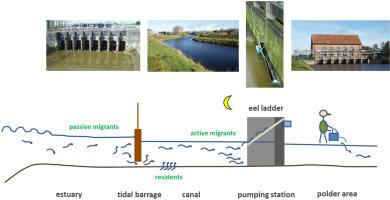Estuarine, Coastal and Shelf Science ( IF 2.8 ) Pub Date : 2020-11-27 , DOI: 10.1016/j.ecss.2020.107127 Jeroen Van Wichelen , Pieterjan Verhelst , David Buysse , Claude Belpaire , Kristof Vlietinck , Johan Coeck

|
Tidal barrages on water ways constitute a major threat for diadromous fish species such as the critically endangered European eel (Anguilla anguilla L.). An unobstructed migration route between the spawning area in the Sargasso Sea and the freshwater growth habitats in Europe is crucial for the European eels’ long-term survival. Every spring however, millions of glass eels arrive at the European coast to find their inland migration route blocked. Adjusted tidal barrage management (ATBM), i.e. setting the tidal sluice doors ajar during tidal rise, is one of the mitigation measures to enhance glass eel colonisation. Although this management substantially improves the number of incoming glass eels, the fate of these migrants, confronted with abruptly shifting conditions upon sluice passage, remains un-investigated. Glass eel upstream dispersion after sluice passage by means of ATBM was investigated in a drainage canal connecting a small estuary with an adjacent polder area in Belgium. Large numbers of glass eel caught with eel ladders installed at a pumping station about 800 m upstream the tidal barrage indicate that glass eels were well able to switch to an active counter current swimming behaviour to continue upstream dispersion. On the other hand, some glass eels did not initiate active migration but settled in artificial substrates placed in the canal instead. These residents however appeared very successful in using the canal as feeding ground and in time substantially increased their overall fitness. The appearance of both migration strategies (switch to active migration or successful settlement) in this canal shows the potential of ATBM as a valuable tool for the management and restoration of the European eel population and calls for a wide application of this cost-efficient mitigation measure.
中文翻译:

通过调整潮汐弹幕管理人工摄入后的玻璃鳗(Anguilla anguilla L.)行为
水道上的潮汐拦河坝对诸如濒临灭绝的欧洲鳗鱼(Anguilla anguilla)这样的缺水鱼类构成了重大威胁。L.)。藻类海藻产卵区与欧洲淡水生长栖息地之间的畅通无阻的迁徙路线对于欧洲鳗long的长期生存至关重要。然而,每年春天,数百万只鳗鱼到达欧洲海岸,发现其内陆迁移路线被封锁。调整潮汐拦河坝管理(ATBM),即在潮汐上升期间将潮汐闸门打开,是增强玻璃鳗定殖的缓解措施之一。尽管这种管理大大改善了进入玻璃鳗的数量,但这些移民的命运在水闸通过时面临突然变化的条件,仍未进行调查。在连接小河口和比利时邻近田地区的排水渠中,研究了通过ATBM通过闸门通过后的玻璃鳗上游分散。在潮汐拦河坝上游约800 m处,大量鳗鱼被梯e捕获,该梯子安装在泵站上,这表明鳗鱼能够很好地切换到主动逆流游泳行为,以继续上游扩散。另一方面,一些玻璃鳗并没有主动迁移,而是沉积在放置在运河中的人工基质中。然而,这些居民在使用运河作为觅食场方面似乎非常成功,并且及时地大大提高了他们的整体健康水平。在这条运河中出现的两种迁徙策略(转向主动迁徙或成功定居)都显示出ATBM作为管理和恢复欧洲鳗鱼种群的宝贵工具的潜力,并呼吁广泛采用这种具有成本效益的缓解措施。


























 京公网安备 11010802027423号
京公网安备 11010802027423号